- Clone
- HI98 (See other available formats)
- Regulatory Status
- RUO
- Workshop
- IV M141
- Other Names
- Lewis X, 3-FAL, 3-FL, LNFP III, Lex , SSEA-1, X-hapten
- Isotype
- Mouse IgM, κ
- Ave. Rating
- Submit a Review
- Product Citations
- publications

-

Human peripheral blood granulocytes stained with HI98 FITC
| Cat # | Size | Price | Quantity Check Availability | Save | ||
|---|---|---|---|---|---|---|
| 301903 | 25 tests | 68€ | ||||
| 301904 | 100 tests | 153€ | ||||
CD15 is 3-fucosyl-N-acetyllactosamine (3-FAL), also known as Lewis X, 3-FAL, X-hapten, and SSEA-1. CD15 is expressed on granulocytes and monocytes. It has also been shown to be expressed on Langerhans cells and some malignant cells. CD15 has been implicated in adhesion, as well as chemotaxis, phagocytosis, and bactericidal activity.
Product DetailsProduct Details
- Verified Reactivity
- Human
- Reported Reactivity
- Chimpanzee
- Antibody Type
- Monoclonal
- Host Species
- Mouse
- Formulation
- Phosphate-buffered solution, pH 7.2, containing 0.09% sodium azide and BSA (origin USA)
- Preparation
- The antibody was purified by affinity chromatography and conjugated with FITC under optimal conditions.
- Concentration
- Lot-specific (to obtain lot-specific concentration and expiration, please enter the lot number in our Certificate of Analysis online tool.)
- Storage & Handling
- The antibody solution should be stored undiluted between 2°C and 8°C, and protected from prolonged exposure to light. Do not freeze.
- Application
-
FC - Quality tested
- Recommended Usage
-
Each lot of this antibody is quality control tested by immunofluorescent staining with flow cytometric analysis. For flow cytometric staining, the suggested use of this reagent is 5 µl per million cells in 100 µl staining volume or 5 µl per 100 µl of whole blood.
- Excitation Laser
-
Blue Laser (488 nm)
- Application Notes
-
Clone HI98 has been described to specifically react with 3-fucosyl-N-acetyllactosamine (3-FAL), also called X-hapten, SSEA-1, CD15, or Lewis X. Additional reported applications (for the relevant formats) include: immunohistochemical staining of acetone-fixed frozen sections5 and formalin-fixed paraffin-embedded tissue sections.
- Application References
-
- Knapp W, et al. Eds. 1989. Leucocyte Typing IV. Oxford University Press. New York.
- Schlossman S, et al. Eds. 1995. Leucocyte Typing V. Oxford University Press. New York.
- McMichael A, et al. 1987. Leucocyte Typing III. Oxford University Press. New York.
- Yoshino N, et al. 2000. Exp. Anim. (Tokyo) 49:97. (FC)
- van Baarsen LG, et al. 2014. Arthritis Res. Ther. 16:426. (IHC)
- Product Citations
-
- RRID
-
AB_314196 (BioLegend Cat. No. 301903)
AB_314196 (BioLegend Cat. No. 301904)
Antigen Details
- Structure
- Poly-N-acetyllactosamine
- Distribution
-
Neutrophils, eosinophils, monocytes
- Function
- Adhesion
- Cell Type
- Embryonic Stem Cells, Eosinophils, Monocytes, Neural Stem Cells, Neutrophils
- Biology Area
- Cell Biology, Immunology, Innate Immunity, Neuroscience, Neuroscience Cell Markers, Stem Cells
- Molecular Family
- Adhesion Molecules, CD Molecules
- Antigen References
-
1. Stocks SC, et al. 1990. Biochem. J. 268:275.
- Gene ID
- 2526 View all products for this Gene ID
- UniProt
- View information about CD15 on UniProt.org
Related FAQs
Other Formats
View All CD15 Reagents Request Custom Conjugation| Description | Clone | Applications |
|---|---|---|
| APC anti-human CD15 (SSEA-1) | HI98 | FC |
| FITC anti-human CD15 (SSEA-1) | HI98 | FC |
| PE anti-human CD15 (SSEA-1) | HI98 | FC |
| Purified anti-human CD15 (SSEA-1) | HI98 | FC,IHC-P,IHC-F |
| Alexa Fluor® 488 anti-human CD15 (SSEA-1) | HI98 | FC,IHC-P |
| Alexa Fluor® 594 anti-human CD15 (SSEA-1) | HI98 | IHC-P |
| Biotin anti-human CD15 (SSEA-1) | HI98 | FC |
| Alexa Fluor® 700 anti-human CD15 (SSEA-1) | HI98 | FC |
| PE/Cyanine7 anti-human CD15 (SSEA-1) | HI98 | FC |
| PerCP/Cyanine5.5 anti-human CD15 (SSEA-1) | HI98 | FC |
| Spark Violet™ 423 anti-human CD15 (SSEA-1) | HI98 | FC,IHC-P |
| Spark Violet™ 538 anti-human CD15 (SSEA-1) | HI98 | FC |
Customers Also Purchased

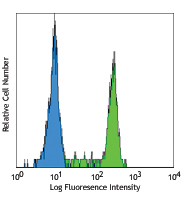

Compare Data Across All Formats
This data display is provided for general comparisons between formats.
Your actual data may vary due to variations in samples, target cells, instruments and their settings, staining conditions, and other factors.
If you need assistance with selecting the best format contact our expert technical support team.
-
APC anti-human CD15 (SSEA-1)
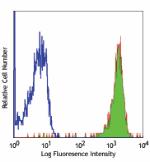
Human peripheral blood granulocytes stained with HI98 APC -
FITC anti-human CD15 (SSEA-1)
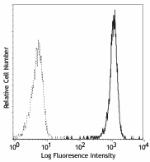
Human peripheral blood granulocytes stained with HI98 FITC -
PE anti-human CD15 (SSEA-1)
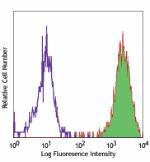
Human peripheral blood granulocytes stained with HI98 PE 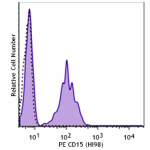
Pre-lysed human blood leukocytes were stained with CD15 (Clo... -
Purified anti-human CD15 (SSEA-1)

Human peripheral blood granulocytes stained with purified HI... 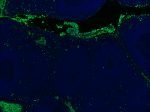
Formalin-fixed paraffin-embedded human tonsil treated with a... -
Alexa Fluor® 488 anti-human CD15 (SSEA-1)
_Antibody_1_FC_072516.jpg&Width=150&altFmImage_path=&Crop=5)
Human peripheral blood granulocytes stained with HI98 Alexa ... _Antibody_2_IHCP_072516.jpg&Width=150&altFmImage_path=&Crop=5)
Human paraffin-embedded tonsil was prepared with standard de... -
Alexa Fluor® 594 anti-human CD15 (SSEA-1)
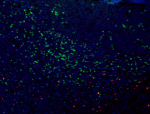
Human paraffin-embedded tonsil tissue slices were prepared w... -
Biotin anti-human CD15 (SSEA-1)

Human peripheral blood granulocytes were stained with biotin... -
Alexa Fluor® 700 anti-human CD15 (SSEA-1)
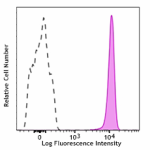
Human peripheral blood granulocytes stained with CD15 (clone... -
PE/Cyanine7 anti-human CD15 (SSEA-1)

Human peripheral blood granulocytes were stained with CD15 (... -
PerCP/Cyanine5.5 anti-human CD15 (SSEA-1)
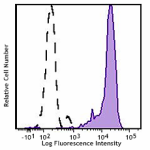
Human peripheral blood granulocytes were stained with CD15 (... -
Spark Violet™ 423 anti-human CD15 (SSEA-1)
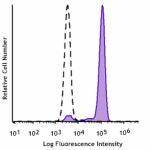
Human peripheral blood granulocytes stained with anti-human ... 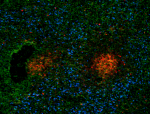
IHC staining of Spark Violet™ 423 anti-human CD15 (SSEA-1) ... -
Spark Violet™ 538 anti-human CD15 (SSEA-1)

Human peripheral blood granulocytes stained with anti-human ...

 Login / Register
Login / Register 














Follow Us